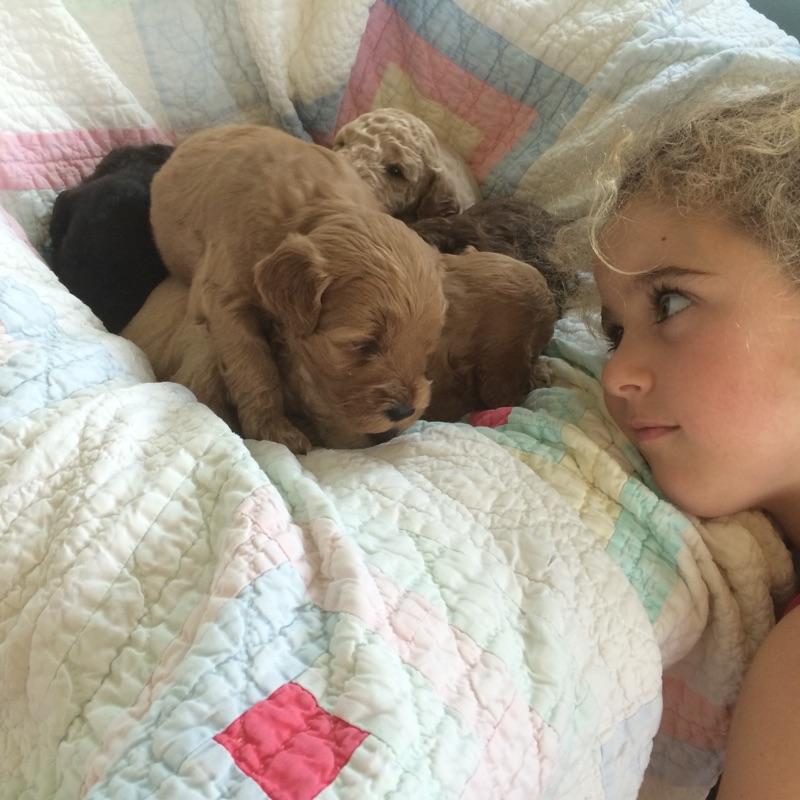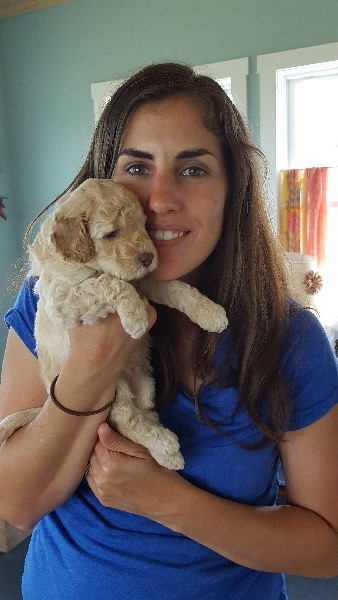Generations of Australian Labradoodles Explained
If the subject hasn’t come up yet, it will.
“Can we get a dog?”
Your kids want a dog to play with, but you don’t want an aggressive breed – or a dog that looks at any kind of training as a personal challenge to be overcome at all costs. Your spouse wants a dog that looks like a dog, not a small stuffed toy. You want a dog that is more than just a mutt with no verifiable history; after all it’s okay for a box of chocolates to be unpredictable (you never know what you’re going to get), but not a 70-pound animal living in your house. Perhaps you want something more like a designer dog. It would be great if the dog didn’t shed, and whatever dog you decide on has to be hypoallergenic because of the allergies in the family.
The affable and adorable Australian Labradoodle dog is known not only for its personality and trainability, but especially for its coat, which can be easy to keep clean and sheds far less than other dogs.
Most people know that the Australian Labradoodles hardly ever shed. That means your house cleaning routine just got easier, and the likelihood that you or your family will react to dog allergens is significantly reduced. These dogs seem to be the perfect for your family life, so of course you’ll want to rush out and select a Doodle to call your own.

You have two options:
First, you can purchase a puppy to raise with your family. Australian Labradoodles can cost anywhere from $3,000 to $5,500, depending on which generation you select and how well the line is known.
Of course, you can rescue a Doodle for less. The only problem is that the rescue may come with a host of issues you are not ready or willing to deal with, including everything from physical challenges to questionable emotional stability. To make matters worse, you won’t even know whether the rescue Labradoodle is an F1, F2 or multigenerational Australian Labradoodle, and that can be a real issue. While it’s true that you’ll get a dog for a lower up front cost, there is an increased uncertainty of risk, including the very real possibility that your Doodle will shed.
Your best bet lies in buying a purebred puppy, and here’s why:
You’re going to want to know all you can about your Labradoodle, starting with questions like these:
- What were his parents like?
- How big were they?
- How healthy will your dog be?
- What kind of coats did they have?
- What kind of coat will your dog have?
- Will the dog shed?
Before you start calling breeders and purchase the first brown-eyed pup you find, you should know that not all Labradoodles are created equal. First, there are two types of Labradoodle – the American Labradoodle, which is considered a hybrid dog, and the Australian Labradoodle, which is considered a purebred.
Our focus is on the purebred Doodle, the Australian Labradoodle.
The purebred Labradoodle from Australia is a cross between a purebred Labrador Retriever and a purebred Standard Poodle. This first breeding or “first crossing” is considered the F1 generation. Other generations of Doodle dogs include the F2 and F3, and these generations can be even more specific, with labels like F1B or F2B.
Do you really need to understand the different generations of Australian Labradoodles? The short answer is yes, and here’s why:
Each Australian Labradoodle generation is characterized with specific traits and types of coat. If you know your Doodle generations, you know what you’re getting with your purebred puppy. You can select the dog that’s right for your lifestyle.

The F1 Generation
This first generation Labradoodle is 50% Labrador Retriever and 50% Standard Poodle, although the Labrador Retriever can also be bred with a Miniature Poodle. The resulting litter is expected to have the best characteristics of both parents, including better health.
This generation of pups, however, could still present with health issues specific to their parents. Like the Standard Poodles and Labrador Retrievers, your puppy could develop hip dysplasia as it grows older. It could also have some of the eye problems Poodles are known for. Conscientious breeders are aware of these possible challenges, and so they health test their dogs to make sure they are not perpetuating physical weaknesses; breeders want to produce the healthiest offspring possible.
The characteristic that makes Labradoodles desirable is their coats.
Most notably in this generation, you’ll see coats that look wiry or scruffy, though it can be difficult to tell what kind of coat the pups will have until they are about eight weeks old. Some offspring may look more like the Labrador Retriever, with hairlike coats, and some may be more similar to the Poodle, with tight curls.
Pups from the F1 Generation are not recommended for people wanting a dog with fewer allergens and less shedding. While you may get a dog that has a fleece or wool-like coat, it can be difficult to tell if your pup will be a shedder, and you likely won’t know until she’s an adult.
The F1 Generation pups are most low maintenance Labradoodles. It’s likely that you won’t to have to keep up with frequent brushing because their coats are shorter and straighter. You’ll probably notice that your dog’s coat becomes thicker with age, so if you live in a warmer climate, you may consider a summer shave for your Labradoodle. Other than that, grooming your F1 Labradoodle is simple and easy.
The F1B Generation
The F1B Generation is backcrossed. That means that an F1 dog has been bred to a purebred dog, either a Labrador Retriever or a Poodle. The purpose behind backcross breeding is to enhance the characteristics of one purebred dog or the other. The most likely mating will be between the F1 Labradoodle and the purebed Poodle, and that’s to achieve the desired no-shed coat. Breeders aim for the hypoallergenic wool and fleece coats.
When the Labradoodle is crossed back to a Poodle, the pups’ coats will become more wavy, with the soft curls that lie in luxurious waves along the body and down the legs. This is more similar to the coat for which Poodles are known. It’s one of the easiest coat type to care for, but until your puppy reaches adulthood, you’ll have to brush your dog regularly to make sure she doesn’t develop matting.
If you’re looking for an Australian Labradoodle because you’ve heard that these dogs fit well with family members who have moderate to severe allergies, the backcrossed Labradoodle is a the best choice for your lifestyle. Theses dogs shed minimally, produce little dander, and make great canine companions.
F2 Generation
If you cross an F1 Labradoodle with another F1 Labradoodle, you get an F2 Generation puppy.
You still have a dog that is 50% Labrador Retriever and 50% Poodle, but you will find the most variations in this generation of dogs. In the F2 Generation, your pup could have any type of coat – fleece, wool or hair, and it could be straight, wavy or curly. The challenge with the F2 Generation is that the dogs with hair coats will produce the kind of dander that triggers allergies, but you won’t know for sure which coat your dog has until it becomes an adult. There’s no guarantee that your dog will have the fleece or wool coat that is more suited to allergy sufferers.
Unfortunately, you may experience more shedding than you had hoped for, so the way to correct this deficiency is through crossback breeding once again.
F2B Generation
As you may have already guessed, the F2B Generation is the mating of one F2 Generation dog to a purebred Labrador Retriever or Poodle. Again, the preferred purebred is the Poodle in order to produce a coat that doesn’t shed or exacerbate allergies.
The F2B dog that has been mated to a Poodle will have the soft, curly coat so coveted by Australian Labradoodle owners. This coat, which will be fleece or wool, is much softer to the touch, and it feels thicker, too. If you are looking for a dog that’s not going to shed too much, you may want to consider the F2B Generation for your needs.
Be aware, though, that this dog’s coat grows continuously. That means frequent brushing to keep away the tangles and trips to the groomer – or you’ll have to learn how to groom and trim your dog yourself.
You can also get an F2 dog by breeding an F1 Generation dog to a dog from the F3 or F4 Generations.
F3 Generation
Cross two F2 Generation Labradoodles with each other, and you will have F3 Generation Labradoodle puppies. As you might expect, these dogs share equal parts of Labrador Retriever and Poodle.
It’s when you crossback these F3 Generation dogs, however, that you reach perfection in the Australian Labradoodle breed. The offspring of these matings is the famed F3B Generation that saavy breeders and owners look for.
These are the nearly hypoallergenic dogs that pet lovers adore.
“Most people prefer the multi-generational Australian Labradoodle, not only because of their non-shedding coats but because they are consistently similar dogs.”
F3B Generation
The F3B Generation is a dog that has been backcrossed to a parent purebred. The most common choice for backcrossing is the Poodle, obviously for its coat. The dogs are rarely crossed back to a Labrador Retriever.
Most Australian Labradoodles are F3B Generation dogs. These multigenerational dogs develop great coats of curly fleece. They shed very little, and they are perfect for those people who have allergies.
You’ll still find yourself brushing your dog regularly, and he will still need to visit a groomer for trimming and/or clipping because of his continuously growing coat.
Breeding beyond the F3B produces multi-generational litters of puppies, and these dogs are highly coveted because of their consistency in health, form and coat. They always look predictably like their parents. Opt for a dog from the F3B Generation, and you have less chance of having a throwback pup, which means a dog that looks more like its original purebred parent from several generations ago than the cute and hypoallergenic Labradoodle you were hoping for.
Dogs from the F3B Generation will cost more, but in return, you get a designer dog that will be healthy and as hypoallergenic as a dog can be.
The multi-generational Australian Labradoodle will be the smart family companion that will be funny, lovable, easy to train – just the kind of canine companion kids should grow up with. It’s also the kind of dog that’s easier to care for because it’s the least likely generation to shed.